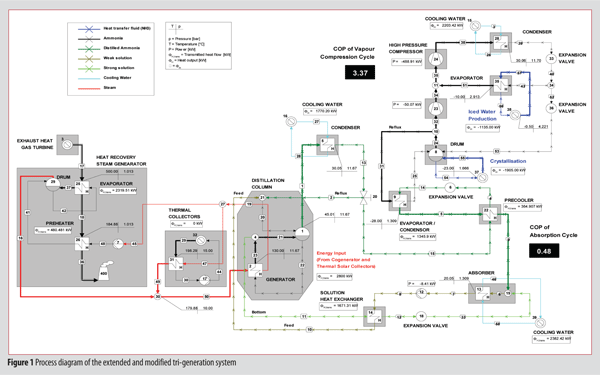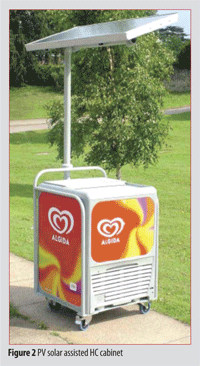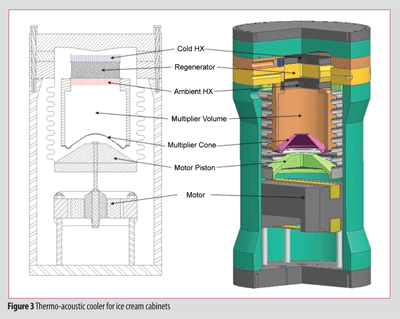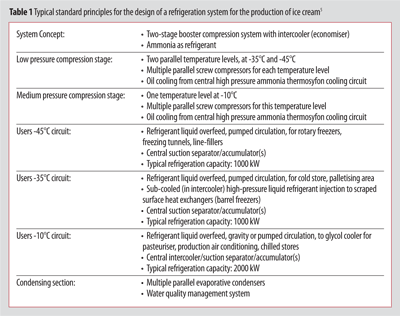Refrigeration and Unilever
- Like
- Digg
- Del
- Tumblr
- VKontakte
- Buffer
- Love This
- Odnoklassniki
- Meneame
- Blogger
- Amazon
- Yahoo Mail
- Gmail
- AOL
- Newsvine
- HackerNews
- Evernote
- MySpace
- Mail.ru
- Viadeo
- Line
- Comments
- Yummly
- SMS
- Viber
- Telegram
- Subscribe
- Skype
- Facebook Messenger
- Kakao
- LiveJournal
- Yammer
- Edgar
- Fintel
- Mix
- Instapaper
- Copy Link
Posted: 22 February 2010 | Rene van Gerwen, Global Lead Engineer Refrigeration & HVAC, Engineering Excellence Team (EET), Unilever Global Supply Chain and Jan Krieg, Expertise Team Leader Systems & Process Engineering, Unilever R&D | No comments yet
Unilever is one of the world’s largest FMCG companies, branding, selling and producing food, personal care, cleaning and washing products. The company has a global turnover of more than 40 billion Euros per year (divided equally between the three major regions: Western Europe, the Americas and Africa/Asia/Central-Eastern Europe). Unilever sells products in 150 countries and has more than 400 production facilities in 100 countries.
Unilever is one of the world's largest FMCG companies, branding, selling and producing food, personal care, cleaning and washing products. The company has a global turnover of more than 40 billion Euros per year (divided equally between the three major regions: Western Europe, the Americas and Africa/Asia/Central-Eastern Europe). Unilever sells products in 150 countries and has more than 400 production facilities in 100 countries.
Unilever is one of the world’s largest FMCG companies, branding, selling and producing food, personal care, cleaning and washing products. The company has a global turnover of more than 40 billion Euros per year (divided equally between the three major regions: Western Europe, the Americas and Africa/Asia/Central-Eastern Europe). Unilever sells products in 150 countries and has more than 400 production facilities in 100 countries.
Many food products such as ice cream, margarine, frozen foods and snacks require refrigeration in almost all stages of the supply chain (cold chain). Other products such as ice tea and certain snacks require refrigeration at point of sale or consumption. Unilever is therefore one of the largest users of refrigeration worldwide. This article explains the world of refrigeration in Unilever and details of several recent developments.
Refrigeration in the production of ice cream, margarine, frozen foods and snacks
These food products require complicated process cooling. As the production scale is large in most factories (e.g. production volumes of 100 to 200 million litres of ice cream per production plant per year), large, centralised refrigeration systems are used, with multi-stage booster compression and multiple temperature levels. The conceptual design for this is standardised as much as possible. Table 1 shows typical standard principles for the design of a refrigeration system for production of ice cream.
The realisation of new refrigeration plants and significant expansions or modifications of existing plants is preferably done with major internationally operating specialist refrigeration contractors/suppliers, capable of executing the design and contracting work as well as supplying major components.
Ammonia, the preferred refrigerant for industrial refrigeration
Ammonia was, is and will be the preferred refrigerant for industrial refrigeration. There are no environmental concerns; it is energy-efficient and safe when adequately managed6. Unilever has mandatory internal safety standards for ammonia refrigeration systems. In countries where stricter national regulatory requirements exist than described in these internal Unilever standards, then these must take precedence over Unilever requirements.
A few examples of these internal requirements are given below:
» System, component & piping design, material choice, construction and installation must be in accordance with one of the following accepted international standards: EN 378, ANSI/IIAR 2, ANSI/ASHRAE15, ISO 5149 or ASME, including the relevant associated standards. If national standards are used, full equivalence with the above mentioned international standards must be ensured
» Pressure vessels must comply with either ASME Section 8 or the European Pressure Equipment Directive (PED). If national standards are used, full equivalence with the above mentioned international standards must be ensured
» System parts with a risk of liquid ammonia block-in (e.g. liquid lines with stop valves at both ends) must have provisions to prevent excessive pressure (e.g. internal overflow valve)
» To reduce the risk of brittle fracture, all materials used for ammonia pipework, vessels, welding consumables, compressor and valve housings must have an impact strength of at least 27 J at the minimum operating temperature to be verified by material certificates or material sample tests
» To reduce the risk of ammonia stress corrosion cracking (ASCC), all ambient temperature ammonia pressure vessels must be thermally stress relieved after fabrication, including all welded-on connections. Alternatively, hot formed or stress relieved vessel heads and other curved parts, in combination with adequate automatic air purging, are acceptable
» Welding quality must be according to ANSI/ASME IX, EN287/EN288 or equivalent
» Welding quality must be inspected directly after construction, by persons qualified according to EN473 or ASNT level II or equivalent, using X-ray techniques. One hundred per cent of the welds of a pressure vessel must be X-rayed. For the ammonia pipework, a sample of at least 10 per cent of each welder’s output, selected at random, must be X-rayed. When inspection results are unsatisfactory, the welds must be replaced and the inspection sample must be increased
We continue to seek further opportunities for improvement. CO2 as a refrigerant in the low pressure stage has a number of benefits. However, many complications arise in process refrigeration (such as the complete redesign of complex and expensive production line equipment, originally designed for use with ammonia).
Application of thermally driven systems for industrial refrigeration
Interesting opportunities for improvement can be found in the application of thermally driven refrigeration systems (i.e. absorption) combined with heat sources such as process heat, waste heat from a local CHP plant (Combined Heat & Power generation) and from solar panels. A comparative study in this field1 has examined how much fuel can be saved by applying solar electric and/or solar thermal energy. Thermal energy is generated by solar collectors, while photovoltaic collectors directly generate electric power. To combine these energy streams with an absorption refrigeration plant, which is powered by heat generated by a CHP plant, a hybrid system can be created. This hybrid system has been studied by using a model for tri-generation systems, which generates heat, power and refrigeration capacity (Figure 1).
The model was adapted to the specific conditions of a reference Unilever factory. Electricity is used for powering the two-stage vapour compression refrigeration system. The thermal energy from the solar collectors is added to the hot water part of the system. The electrical energy from the photovoltaic collectors is added to the electrical energy that is generated by the CHP system.
This type of hybrid system will save eight per cent in fuel usage for an application in the Netherlands and 16 per cent fuel saving in a similar application in Barcelona, hence leading to similar percentages of CO2 emission reduction. CHP could offer opportunities for combining waste heat, e.g. from neighbour companies and/or solar energy to reduce the environmental impact. In view of the considerable investment in sustainable solar energy supported systems combined with refrigeration, an increasing number of applications using these solar supported systems will only take place if the pay back time is reduced to values which are considered acceptable by the industry (mostly less than five years).
Unilever is continuously searching for sustainable technologies to further reduce CO2 emissions from energy. Today, several CHP systems, some of them combined with absorption refrigeration and/or solar energy, are realised or in the construction or planning phase on Unilever sites, mainly in Europe.
Refrigeration at point-of-sale for ice cream
The sale of ice cream requires specifically designed ice cream freezer cabinets. Most of those are owned by Unilever and operated by kiosk owners, petrol station operators etc. As the world’s largest producer of ice cream, we own approximately two million ice cream cabinets worldwide. Our leading position in this market allows us to be pro-active in reducing negative environmental effects from operating these cabinets.
Since 2000, an internal research, development & rollout program is in progress, with short- and long-term goals, starting with an initial feasibility study2.
Virtually all ice cream cabinets apply the refrigerant vapour compression principle, with an evaporating and condensing refrigerant. Current standard are the HFC refrigerants like R134a and R404A, without ozone depletion, but with a strong contribution to the greenhouse warming effect (per kilogram, 1,500 to 3,000 times the contribution of CO2). In 2001, we announced that by 2005, no HFC containing cabinets will be purchased, where alternatives are economically feasible and legally allowed. It appeared that hydrocarbons (HC, especially Propane or R290) are the only natural alternative to HFCs in such small hermetic low temperature systems that could be quickly and cost-effectively implemented. Because reliability and safety are essential, detailed risk assessments, design changes, laboratory / field testing and training of service personnel have been performed3. By the end of 2009, we were operating more than 400,000 cabinets with hydrocarbons globally. As these kinds of cabinets have an average lifetime of seven years or more, it takes several years before the full fleet will be HFC-free.
In the United States, hydrocarbon refrigerant is still not legally allowed. Therefore, a formal approval application for hydrocarbon as refrigerant in ice cream cabinets has been submitted to the US EPA SNAP Program by Unilever’s US-based daughter company Ben & Jerry’s. This is a complicated and lengthy process, where by as of the end of 2009, several field trials were in progress.
Another development project is focusing on PV solar-assisted HC cabinets. Several of those cabinets are in use today (Figure 2).
A very innovative activity is related to the development of a thermo-acoustic cooler for ice cream cabinets. A prototype has been working for some years with a Ben & Jerry’s ice cream cabinet in the U.S.4 (Figure 3). Although working well, the concept is currently not mature enough and too expensive for widespread rollout.
The ‘Refrigerants, Naturally!’ initiative was launched in 2004 with the Coca Cola Company, Unilever and McDonald’s. These companies committed to an HFC-free future, with a focus on their point-of-sale cooling applications. In addition to the corporate members, Greenpeace and the United Nations Environment Programme (UNEP) support Refrigerants, Naturally! and have acted in an advisory capacity in its management. In 2006, Carlsberg & PepsiCo joined the initiative. (More information on www.refrigerantsnaturally.com)
Energy and greenhouse gas emission reduction in manufacturing
The global target for CO2 emissions related to energy use in factories is to reduce emissions by 25 per cent in 2012 compared to 2004, measured per tonne of product.
For an ice cream factory, 50-70 per cent of the total electricity consumption is related to the central refrigeration system, so refrigeration is a key area for achieving this target.
Saving options are: minimising the refrigeration demand, optimising set points and controls, application of variable speed drives on compressors, pumps and fans, smart production processes and process integration, heat recovery, combined heat, refrigeration and power (CHRP) and solar energy utilisation.
More details about Unilever and the environmental targets and achievements can be found on www.unilever.com








References
- Ezzahiri, S, Infante Ferreira, C, Krieg, J., Gerwen, R. van, 2009, CHP Solar assisted refrigeration system, International Institute of Refrigeration, 3rd Conference on Thermo Physical Properties and Transport Processes of Refrigerants, Boulder, CO, USA
- Gerwen, R. van et al, 2002, Perspective of novel refrigeration technologies SENTER / NOVEM 375007/0060 Contract, Final Report (in Dutch)
- Gerwen, R. van et al, 2008, Ice cream cabinets using a hydrocarbon refrigerant: from concept to global technology rollout, International Institute of Refrigeration, 8th Gustav Lorentzen Conference – Natural Working Fluids, Copenhagen, DK
- Poese, M, Smith, R, Garrett, S, Gerwen, R. van, and Gosselin, P, 2004, Thermo Acoustic refrigeration for ice cream sales, International Institute of Refrigeration, 6th Gustav Lorentzen Conference – Natural Working Fluids, Glasgow UK
- Gerwen, R. van, Unilever and Refrigeration, RCC Total Energy No. 3, July 2009 (in Dutch)
- Pennartz, A, Gerwen, R. van, Ammonia safety in practical situations, RCC Koude & Luchtbehandeling, November 2009 (in Dutch)




